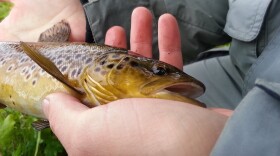As dwindling brook trout populations are a concern across Wisconsin, conservation efforts in Iron County are increasing viable habitats for the native species.
Fish population spikes are being observed at Kaari Creek and the Tyler Forks River after major culvert replacement and restoration projects.
Zach Lawson, Iron and Ashland counties fisheries biologist for the Wisconsin Department of Natural Resources, said post-project monitoring showed a 94% increase in juvenile trout at Kaari Creek, and fishermen at Tyler Forks report seeing more juvenile trout than they have in a decade.
"We see a more even distribution of different size and age classes throughout the stream, along the entire reach of Kaari Creek, which is fantastic," Lawson emphasized. "Just what we want to see."
Lawson pointed out brook trout are important as a good indicator of high-quality water resources. Despite the fluctuating weather conditions of climate change, Iron County is predicted to be one area in Wisconsin where brook trout will still be able to thrive. Lawson stressed it is why projects like these are so crucial.
Kaari Creek, which serves as a nursery habitat for brook trout, had been diverted from its natural channel into a roadside ditch, causing erosion and flooding issues. Improving it meant replacing nine culverts and an 800-foot stream restoration that cost more than $400,000 dollars to complete.
Heather Palmquist, county conservationist for Iron County, said most of the funds came through the Wisconsin Department of Natural Resources’ Trout Stamp Fund.
"Our towns, our private landowners, our Wisconsin DNR, just bringing in all sorts of entities," Palmquist outlined. "Talking with my fisheries biologist about this project, that's how I ended up getting the trout stamp funding. He said, 'Hey, there's a pot of money that maybe we could apply for.'"
Without grant funds and strong partnerships, she added rural, underserved areas like Iron County, with a population of just 6,500, could not undertake such projects.
"They've got small road crews, very small budgets, so a project of this size would not be feasible," Palmquist noted. "These relationships or partnerships up here for us are so incredibly vital."






